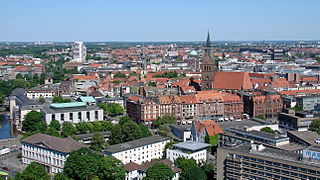
Hanover is the capital and largest city of the German state of Lower Saxony. Its 535,932 (2021) inhabitants make it the 13th-largest city in Germany as well as the third-largest city in Northern Germany after Hamburg and Bremen. Hanover’s urban area comprises the towns of Garbsen, Langenhagen and Laatzen and has a population of about 791,000 (2018). The Hanover Region has approximately 1.16 million inhabitants (2019).

Lower Saxony is a German state (Land) situated in northwestern Germany. It is the second-largest state by land area, with 47,624 km2 (18,388 sq mi), and fourth-largest in population among the 16 Länder federated as the Federal Republic of Germany. In rural areas, Northern Low Saxon and Saterland Frisian are still spoken, albeit in declining numbers.

The Nordstadt is the university quarter in the German city of Hanover. Part of the borough Hanover-Nord, it has 17,684 inhabitants (2020).

Hanover Zoo is located in the city centre, or Mitte borough, of Hanover, Germany. The zoo was established on 4 May 1865, and comprises an area of 22 hectares. It contains about 3,414 animals in 237 species, which are cared for by more than 400 employees in the summer season.

Northeim is a town in Lower Saxony, Germany, seat of the district of Northeim, with, in 2011, a population of 29,000. It lies on the German Half-Timbered House Road.

Winsen (Luhe) is the capital of the district of Harburg, in Lower Saxony, Germany. It is situated on the small river Luhe, near its confluence with the Elbe, approx. 25 km southeast of Hamburg, and 20 km northwest of Lüneburg.

Burgdorf is a town in the Hanover Region, in Lower Saxony, Germany. It is situated approximately 22 km northeast of Hanover. Until 1974, Burgdorf was the capital of the Burgdorf district. The town and its surrounding areas are known for the tradition of growing white Asparagus and for breeding Hanoverian horses. Burgdorf hosts a monthly horse market from April to September every year.

Theodor Lessing was a German Jewish philosopher.

The Eilenriede is a 640-hectare (1,600-acre) municipal forest in Hannover, Germany. It is the largest urban city forest in Germany, and also one of the largest in Europe. The Eilenriede is nearly twice the size of Central Park. The biggest German urban "park" in the strict sense of the word, however, is the Englischer Garten München, with "only" 375-hectare (930-acre).
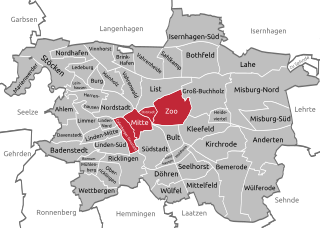
Mitte is the first borough of Hanover, the state capital of Lower Saxony. As of 2020, it has 36,645 inhabitants and consists of the quarters Mitte, Calenberger Neustadt, Oststadt and Zoo. The district mayor is Cornelia Kupsch (CDU).
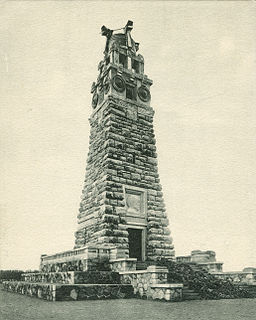
The Bismarck Tower in Hanover, Germany was a tower erected as a monument to the first Chancellor of the united German nation Otto von Bismarck for patriotic and nationalistic purposes, which then became a hub for national socialist events in the city until its dismantlement in 1935 as part of the building of the Maschsee.

The Gartenfriedhof or Garden Cemetery is a cemetery in Hanover, created in 1741 and located by the Gartenkirche. The cemetery and the church are both named after the garden parish outside the city walls in front of Aegidien gate. The cemetery, which contains a number of classicising grave markers from the first half of the nineteenth century, was closed in 1864 with the establishment of the Stadtfriedhof Engesohde. Today it forms a park in the middle of inner city Hanover. The graves of Charlotte Buff, the astronomer Caroline Herschel and the painter Johann Heinrich Ramberg are located here. The Gartenfriedhof lies on Marienstraße between Warmbüchenstraße and Arnswaldtstraße.
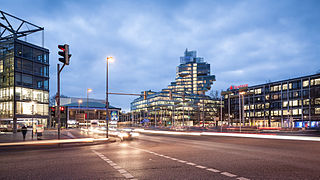
The Aegidientorplatz, colloquially known as Aegi is a busy square in Hanover located above the U-bahn station of the same name. The square was named for the Aegidientor, one of the city gates of Medieval Hanover, which existed until 1780.
The following is a timeline of the history of the city of Hanover, Germany.

Linden-Limmer is the tenth borough (Stadtbezirk) of Hanover, the state capital of Lower Saxony. It became part of the city in 1920. Linden-Limmer is where Hannah Arendt was born. It has 44,941 inhabitants (2020) and consists of the quarters (Stadtteile) of Linden-Mitte, Linden-Nord, Linden-Süd and Limmer.

The Bombing of Hanover was a series of eighty-eight air raids by RAF Bomber Command and the United States Army Air Forces on the German city of Hanover during World War II. 4,748 residents and 2,034 others were killed. Around 1,000 aerial mines, 34,000 high explosive bombs, 900,000 incendiary bombs and 50,000 fire bombs were dropped. The heaviest raid was that by the RAF on the night of 8/9 October 1943, killing 1,245 people. This was an example of the carpet bombing of suburban and residential civilian targets laid out in the 14 February 1942 Area Bombing Directive.
Dudensen is a village of Neustadt am Rübenberge in the district of Hanover, Lower Saxony in Germany. It had a population of 530 in 2021.
Heinrich Lutter was a German pianist and piano educator.

Historisches Museum Hannover is a historical museum Hanover, Lower Saxony, Germany, founded in 1903 as Vaterländisches Museum der Stadt Hannover. Its collections are related to the history of the city, the history of the governing House of Welf, and of the state of Lower Saxony.
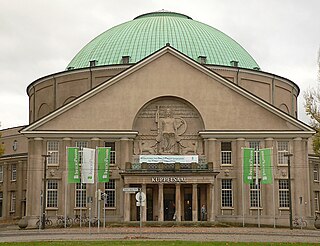
The Stadthalle Hannover is a concert hall and event venue in Hanover, the capital of Lower Saxony, Germany. The large hall is called Kuppelsaal, after its dome. The hall was opened in 1914. It is the largest hall for classical music in Germany, seating 3,600. Severely damaged during World War II, it was restored slightly altered. The hall is now part of the Hannover Congress Centrum. The listed historic building is a landmark of the city.




















